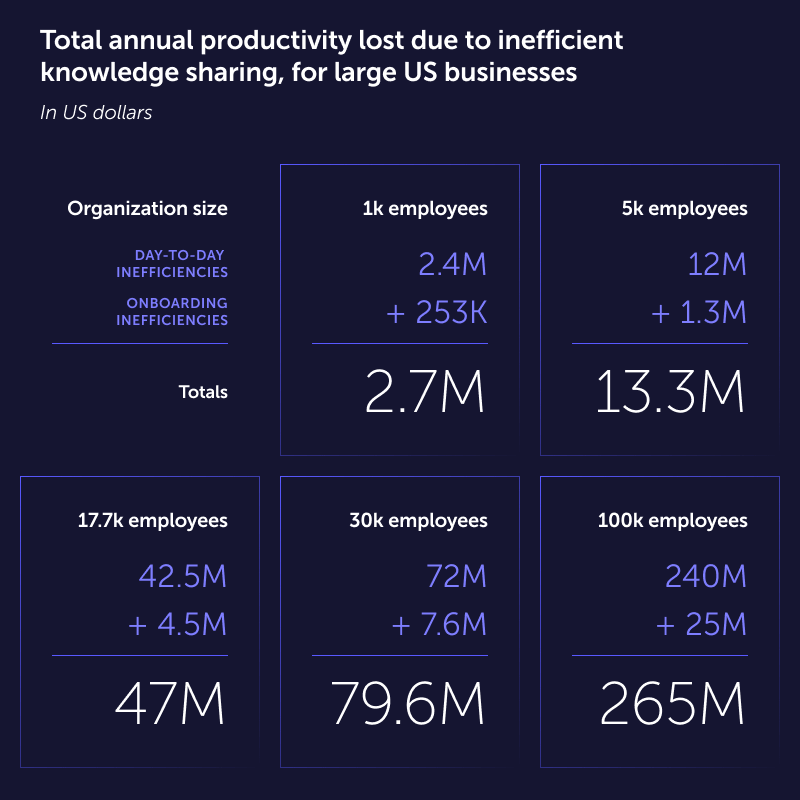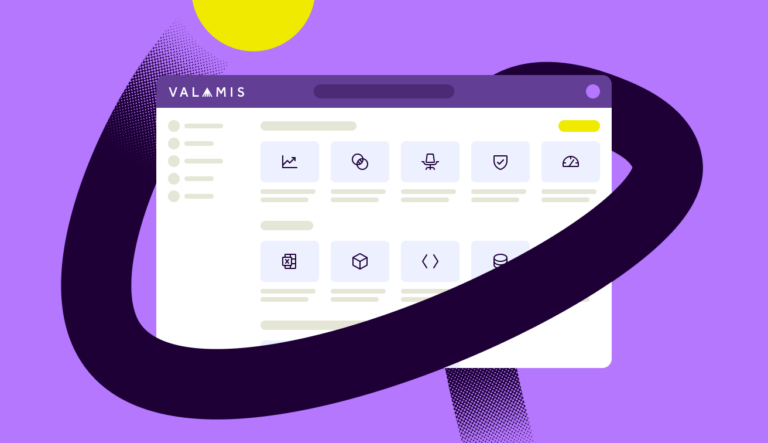Institutional Knowledge
Learn what institutional knowledge is and why it is important. What the benefits and downsides are? Discover how to save it in an organization.

Maintaining knowledge and expertise is a critical part of running a successful organization.
While innovation and new business approaches can lead to significant growth, it works best when employees are informed by what has come before and have an understanding built up by the shared workplace.
Discover:
- What is institutional knowledge?
- Examples of institutional knowledge in action
- Types of institutional knowledge
- The importance of institutional knowledge
- The benefits of implementing institutional knowledge management
- Downsides of over-relying on institutional knowledge
- How to save institutional knowledge inside an organization
What is institutional knowledge?
Institutional knowledge is the sum of information a company and its employees possess. This can include the expertise, policies, data, skillsets, techniques, know-how, processes, values, and experiences that cover the organization’s entire history or are brought to the institution by new hires.
Think of institutional knowledge as the collective memory of the company, providing a blueprint for everything job-related and helping staff perform tasks not just to the best of their ability but to the best of the institution’s ability.
As companies grow, they develop ways of working that best suit their requirements. These strategies and all the knowledge they contain are then taught to new team members, helping them learn how to approach tasks and overcome common problems that arise.
Companies with proper knowledge management strategies ensure expertise spreads throughout the workforce. Conversely, companies without appropriate information-sharing strategies allow institutional knowledge to accumulate and remain with only a few vital employees, leaving them potentially vulnerable to losing essential information for their business.
Knowledge management and effective documentation processes mean staff members can receive support from previous employees rather than learn new tasks on their own. This allows institutions to save time and resources, becoming more productive while at the same time minimizing the risks and damage to the business if staff decide to retire or move on.

How to connect skill building to career mobility
You will get four steps to start developing successful skills development and career mobility programs.
Download guideThe goal of sharing institutional knowledge
The primary goal of sharing institutional knowledge is to reduce the gap between experienced staff members and new employees.
This allows employees to build on the pre-existing solutions already found to be effective, ensuring continuity of service as an organization’s workforce changes and evolves over the years.
Examples of institutional knowledge in action
Construction workers
Construction workers must deal with a range of different suppliers for materials and equipment. Through experience, staff can learn the best approach for working with each supplier.
For example, this could be information on the best quality goods for a particular project or any additional instructions the supplier may require.
Through repeated use, construction workers build up institutional knowledge that improves the process for everyone involved.
By teaching this unique knowledge to new employees, the company can improve operations, create a better-informed workforce, and retain expertise for future work.
Sales
A significant part of sales is building a rapport with current and potential clients.
Nurturing good professional relationships with contacts on the customer side helps retain and generate new leads for the business.
Also, getting to know the customer and gaining a deeper understanding of their needs produces greater customer satisfaction.
By sharing the institutional knowledge, a sales team can help maintain the quality of service irrespective of the staff involved.
Types of institutional knowledge
Generally speaking, institutional knowledge can be separated into two groups:
- Explicit or tangible knowledge
- Implicit or intangible knowledge
This grouping and concept came from human memory studies.
Explicit knowledge
Explicit knowledge refers to knowledge that is easy to articulate, store, and share with new people.
This could be through documentation such as records, reports, datasheets, white papers, and many other methods.
Explicit knowledge is the outcome of processing, analyzing, and structuring measurable data and facts.
Implicit knowledge
Implicit knowledge refers to how explicit knowledge is applied in real-world scenarios. It is generally harder to define, store, and share.
For example, it could refer to personal knowledge and stories about overcoming an issue or dealing with a client.
Unlike explicit knowledge that can be easily codified and taught, implicit knowledge is generally based on experience or intuition and requires significant training or mentorship to maintain.
Because of this, implicit institutional knowledge is easier to lose during employee turnover.
Explicit vs. Implicit Knowledge
To demonstrate the difference between the two types, consider a company dealing with an existing client.
The explicit knowledge is easy to find. Staff can go through records to discover previous interactions (projects, deliverables, timelines, payments, etc.).
However, implicit knowledge related to the client can be harder to define.
Previous staff working on the account may have knowledge of specific details that improved client experience. This could be the intricacies of how the client likes to work or even a personal connection that has developed over time.
Implicit knowledge is harder to write down and pass on and can require interaction with the previous employees directly involved.
The importance of institutional knowledge
As employees remain at a company for extended periods, they acquire more institutional knowledge and gain greater responsibilities, becoming more proficient in a range of areas related to the business.
It is common for companies to end up with long-serving staff whose most significant value is the knowledge they possess. These staff members act as hubs of expertise, vital nodes in the employee network that provide information to departments or individuals.
This is a regular occurrence, and institutional knowledge naturally accumulates with specific individuals who show just how important it can be. Companies must manage these individuals properly to ensure their expertise is passed on to others if they choose to retire or leave.
The potential knowledge gaps they leave behind can cause significant harm to the organization. Key long-serving employees leaving an organization often take with them unique expertise, connections, and the know-how related to a range of business processes.
Without a conduit connecting the right staff across the organization at the right time or providing helpful resources and insights, the institution’s overall performance drops.
Information can also become isolated to different departments without key connective staff to facilitate sharing. This leads to slower operations, with teams struggling to find the information they need to perform their tasks at previous levels and unexpected issues compounding rather than being quickly remedied based on past experience.
Institutional knowledge defines how a business operates. How an organization did things in the past will always affect what it will do in the future. However, improving performance and translating this into a competitive advantage requires efficient procedures that spread information to all relevant employees.

How to connect skill building to career mobility
You will get four steps to start developing successful skills development and career mobility programs.
Download guideInstitutional knowledge research
A survey of 1001 US employees across various industries by Panopto and market research company YouGov found the two primary downsides of unshared knowledge are onboarding and day-to-day productivity. They estimated the cost of inefficient knowledge sharing for US businesses with a range of workforce sizes:

Source: www.panopto.com
The importance of practical knowledge sharing is supported by research from McKinsey.
For example, interaction workers (employees involved in the coordination required to exchange goods and services) spend on average 20% of their workweek looking for internal information or finding the right colleague to help with specific tasks.
The benefits of implementing institutional knowledge management
1. Fewer information silos
Sharing data and knowledge across the organization prevents it from remaining in one place.
Plus, sharing institutional expertise across teams and departments helps staff spot potential operational improvements.
2. Reduced mistakes due to lack of experience
Institutional knowledge helps new staff learn how to best perform their assigned tasks.
3. Efficient onboarding
Institutional knowledge is directly related to the onboarding process.
With effective procedures to teach new hires how to act and perform their duties, you can reduce the time and money required for onboarding.
4. Continuity of service
Managing institutional knowledge reduces disruptions caused by employee turnover.
5. Growth
By assessing past performance, organizations can determine their successes, areas for improvement, and where to target future growth opportunities.
6. Employee satisfaction
Better-informed employees lead to a happier, more satisfied workforce.
Downsides of over-relying on institutional knowledge
While institutional knowledge is vital to running a business, there are downsides when relied upon too much. Over-documenting every process and trying to capture everything related to tasks can lead to wasted employee time and reduced productivity.
Constantly depending on key employees with vast expertise can lead to overwork and potential burnout.
You can’t expect them to be available to every team member and micro-manage all aspects of projects.
Instead, organizations need proper methods for capturing institutional knowledge and making it available when required without over-reliance.
Consequences of losing institutional knowledge
- Drop-in company performance
- Reduced customer satisfaction or lost growth opportunities
- Less effective training material for new staff
- Less efficient processes becoming the norm
- Employees implementing new processes without management approval
- Poorly organized documentation that makes it difficult to find relevant information quickly
How to save institutional knowledge inside an organization
Maintaining expertise becomes a priority when key employees with vast experience leave the organization. However, organizations need a continual and proactive approach to saving institutional knowledge to prevent the gradual loss of information that occurs with every staff member leaving.
Successful organizations make saving institutional knowledge a critical component of business operations and offboarding.
You can’t assume it will naturally spread across your organization. You need to make an explicit strategy to save it.
For example, organizations may undergo a thorough workforce assessment to identify and document their existing institutional knowledge and determine the best approach to disseminate information to new and current employees.
While there is not a single approach to saving institutional knowledge, essential ways to consider include:
1. Knowledge management
To maintain knowledge and expertise, institutions must establish comprehensive knowledge management and documentation processes for all staff to follow. Knowledge management initiatives come in many different shapes and forms. Examples include:
- Mentoring programs
- Comprehensive training
- FAQs
- Tutorials
- Webinars
- Organization-wide internal wikis
- Thorough offboarding processes
- And much more
For a thorough discussion, check out our piece on knowledge management.
2. Succession planning
Succession planning is the process of identifying talent in an organization with the potential for taking on greater responsibilities or more challenging roles. It assesses the current workforce and plans for the future based on potential retirements and staff turnover.
Succession planning creates a plan to fill the void left when essential staff leaves. While this often focuses on lost leadership and management skills, it also includes potential institutional knowledge gaps.
Retaining institutional knowledge to maintain smooth operations during staff changes is a crucial goal of succession planning. It requires the identification of permanent or temporary backups for critical roles within the organization. A vital component of succession planning is identifying these backups and ensuring they work closely with key staff members to pass on their expertise.
With adequate succession planning in place, companies can limit the impact of staff changes and ensure institutional knowledge is shared such that one person alone does not hold all the information required for certain operations.
3. Subject matter experts
The subject matter experts within your organization are indispensable sources of institutional knowledge that you need to maintain.
Leveraging their knowledge is a great way to define optimal procedures for future operations.
Retaining the knowledge of your experts could be through courses or other training material that improve the institutional knowledge of the wider workforce. Internal subject matter experts already present in your staff are the best options to formalize business processes. They take their deep understanding of a subject or field and filter it through the company’s pre-existing operations and information gathered through experience working at the company.
While external subject matter experts may have greater knowledge of a field, they cannot recreate the years of institutional knowledge accumulated while working for an organization.
4. Build a culture of learning and sharing
You need a receptive audience willing to learn and share to save expertise.
Therefore, organizations that promote an open culture where people are eager to learn and share together are less likely to lose institutional knowledge.
5. Create clear and transparent communication channels
A critical factor of institutional knowledge in large organizations is often knowing who to ask.
When working on new or multi-department projects, it can be difficult for staff to know who to go to with queries or if unexpected issues arise.
Collaboration works best when it is fast and not slowed down by added layers of people (supervisors, managers, etc.).
The sharing of information is more straightforward when clear and transparent communication channels are in place – ones that connect the people working on the project directly with the people who know what they need.

How to connect skill building to career mobility
You will get four steps to start developing successful skills development and career mobility programs.
Download guide



